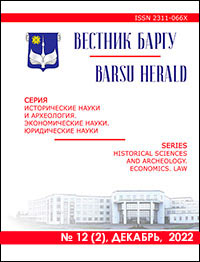STEFCHIK CASHBOXES: IMPLEMENTATION OF THE MODEL OF CREDITAND SAVINGS COOPERATION ON THE TERRITORY OF WESTERN BELARUS (1921—1939)
Keywords:
Western Belarus; interwar period; finance; cooperatives; money; Stefchik cashboxesAbstract
The article is devoted to the study of such a little-studied problem in Belarusian historiography as the activity of credit and savings cooperatives on the territory of Western Belarus in the interwar period. The importance of the cooperative movement for the development of the Western Belarusian region is emphasized. Credit and savings cooperatives built on the model of F. V. Raiffeisen, better known as Stefchik cashboxes, played a special role in the Western Belarusian region; they were based on attracting depositors’
funds and financing projects and initiatives for the development of cooperation in the regions. The article characterizes the main indicators
of the development of credit and savings cooperatives, their activities and the problems that the Stefchik cashboxes faced in the
1920s and 1930s. It is concluded that the main obstacles to the effective operation of cash registers were the difficult financial situation
of the population of the region and the global financial crisis. At the same time, the Stefchik cashboxes became a tool for the unemployed
and poor peasants to organize earnings in production and trade cooperation outside agriculture.
Table 1. Ref.: 16 titles.
Downloads
Published
Issue
Section
License
Copyright (c) 2023 Вестник БарГУ Серия "Исторические науки и археология. Экономические науки. Юридические науки"
Это произведение доступно по лицензии Creative Commons «Attribution-NonCommercial» («Атрибуция — Некоммерческое использование») 4.0 Всемирная.
Авторы сохраняют за собой право заключать определенные договорные соглашения, касающиеся неисключительного распространения опубликованной версии работы (например, размещать ее в институциональном репозитории, публикация в книге) со ссылкой на ее первоначальную публикацию в этом журнале.





